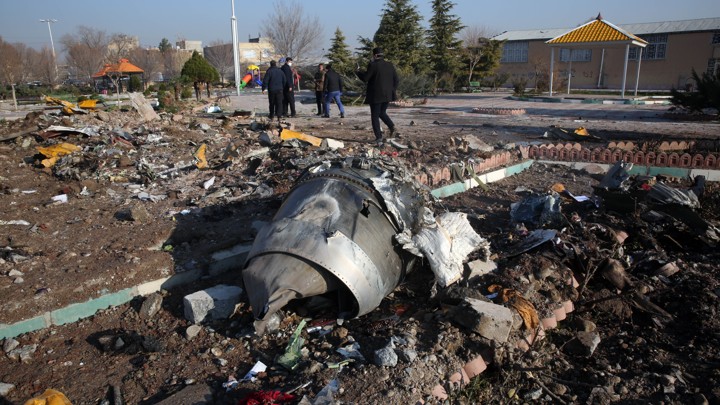ALEXIS C. MADRIGAL
 To be alive in 2020 and connected to the immense information network is to experience a rich confusion of images, videos, social-media posts, and reportage about everything, all the time. The latest example: a Ukrainian-airliner crash outside Tehran. The plane, a Boeing 737-800, crashed shortly after takeoff yesterday, killing everyone aboard. There were unconfirmed rumors and general confusion and Twitter threads with videos, pictures, and analysis of what might have happened. (A missile? A malfunction?)
To be alive in 2020 and connected to the immense information network is to experience a rich confusion of images, videos, social-media posts, and reportage about everything, all the time. The latest example: a Ukrainian-airliner crash outside Tehran. The plane, a Boeing 737-800, crashed shortly after takeoff yesterday, killing everyone aboard. There were unconfirmed rumors and general confusion and Twitter threads with videos, pictures, and analysis of what might have happened. (A missile? A malfunction?)
Beyond and next to the tragedy, it felt as if reality had melted and balled up together in one news story. The U.S. strike on an Iranian general last week had tilted the world toward a new precipice. Boeing’s problems with a different model of 737 have been global-headline news. And, of course, Ukraine is also at the center of geopolitics (not to mention American campaigns).
How could anyone know what had happened? The Ukrainians, Iranians, and Americans were all saying different things (not to mention the Canadians and the British).
That feeling of the complexity of this globe full of people has condensed into a common idea: Despite all the new information we have access to, we actually know less now. Maybe there has been or will be “an information apocalypse,” where technologically sophisticated fakes lead to a breakdown in general epistemological certainty about anything.
But consider the simple but powerful frame that The New York Times gave to a video of what appears to be a missile hitting the plane in Tehran: “Video verified by The New York Times appears to show an Iranian missile hitting a plane above Parand, near Tehran’s airport,” the story begins. The verification is the lede of the story. It’s only a few paragraphs. The video had been floating around on social media. The Times posted the video solely to say: Yes, our reporting says this video is real. Long before the investigation has been completed, the Iranian government’s position that the airplane malfunctioned has been complicated by the emergence of what appears to be a regular person shooting video on a cellphone. If something big happens in public, someone’s got video of it.
The media scholars Britt Paris and Joan Donovan have written about the ways that images have always had a more complicated relationship to the truth than it appears at first. Bits of media don’t have authority all on their own. They must acquire it through the context that surrounds them. Paris and Donovan provide numerous examples: When photographs were introduced into courts, they were deemed less authoritative than written records. Photos did not stand alone as objective truth, and the circumstances of their creation were factored into the court proceedings. Another example: the use and misuse of video during the Rodney King trial, which seemed to show clear-as-day police brutality until defense lawyers began to slow it down and muddy what it seemed to capture.
Newspapers, as we know them, came of age with the Industrial Revolution. Through most of human history, most people didn’t need to know what was happening halfway around the world, and in any case, they couldn’t have known if they’d wanted to. Few people knew much about anywhere beyond their immediate physical surroundings. With railroads and steamships, and telegraphs and radios, everything began to move more quickly. The newspaper, in turn, became a sense-making apparatus, even when the news it delivered actually made the world more confusing and awful. It provided a literal space for verified information in a world newly awash with things to know.
I looked back at a random newspaper from this day in 1920, Minnesota’s Brainerd Daily Dispatch, on newspapers.com. January 9, 1920, was a normal day in Minnesota. Cold, of course. The local-news section noted the comings and goings of several people. So-and-so in St. Paul. Someone in Butte, Montana. A doctor from Minneapolis was in town. But there, on the front page, was news of a volcanic eruption in Mexico. Thousands of people died from “a stream of lava six hundred feet wide.” Farmers were cut down in their fields, their herds killed. The paper recorded no deaths in Brainerd, Minnesota, that day, but to expand concern for more of the world required taking in a more complex, difficult version of what happened on January 9, 1920.
Cellphone videos of police brutality are another instructive example. On their own, they are painful and hard to watch. But police brutality against black people has been a sorrowful tradition in this country. The ubiquity of cellphones didn’t make police more violent but placed their interactions in a new networked context, driving the images into the timelines of wealthier white people. Black Lives Matter activists anchored those images in their systemic critiques of criminal justice. Those images became evidence of how the world really is. What was and what could be seen came into closer accord, even if these videos did not generate perfect agreement about their interpretation.
Given the misinformation, the disinformation, the information operations, the fake news, the “fake news,” the conspiracy theories, the hoaxes, and everything else that makes the current media climate confusing, it’s worth setting the right weights on the other side of the scale. People can and often do know more about what’s happening in the world than they used to, even if that knowledge is partial, prismatic, and uneven. The world isn’t simple, and the ways we come to know it aren’t anymore, either.
No comments:
Post a Comment